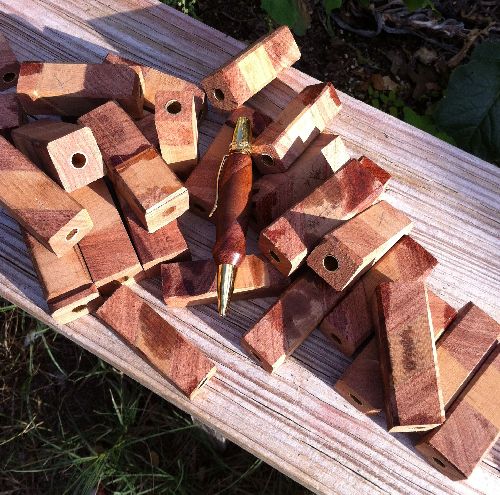I have been making pens to give to all the members of my family. Here is the starting pile of blanks with one example.
The blanks were glued up from mesquite and kauri. Click on the image if you want a better view.
Kauri is pretty nifty wood. If the end grain is exposed on the side when turning, it will brighten and darken to your eye as you rotate the pen in the sun. Very pretty, but this wood is a softwood so working endgrain is rough. The tree this wood came from, fell into a salt bog 40,000 to 50,000 years ago and my source for this wood has dried up. So if there is a flaw in the wood, I work around it and incorporate it into the design. I have had quite a few failures and destroyed a lot of precious wood on the way to making these and learning how to work this wood to it’s best advantage.
Here they are with about half of them made. Click on the image to get a better view, if you are so inclined!
Now that I have a feel for the wood, and know how to work it, I have, of course, ran out of it. In any case, this wood is a bit more pricy than I can usually afford, so I doubt I will have much more occasion to use it. Still it fun to use a wood that grew before what we would recognize as a man, walked this earth.
After having made so many pens, I decided that it would be foolish not to make notes on the process. Here are the steps I take and reminders about what I need to pay attention to. Even though I am finished, there is no reason to forget what I have done. Points 7 through 10 are the ones I don’t want to forget.
1. To laminate a mufti-layer pen I planed the center board flat on both sides. Then I used sandpaper stuck on a granite plate to make the board face really flat. no need to perfectly thickness the board. The boards that glue on either side only need to be flattened like this on one side.
2. Cut the glued boards into blanks and then flatten two adjacent sides. Using the line made by the edge between the sides, line up and evenly square both of the ends and flatten them to be square with the reference sides. Square and flatten the remaining two sides. Make sure your setup is square before trying to make the blanks square.
3. Mount blank in chuck and drill blank. test before using a drill bit for the first time. Make sure the brass sleeve will fit easily but not too loose. Do not trust the pen supply companies to have the right bit size or to have a bit that drills well. Delicate wood can easily be ruined by a bad bit. Drill slowly in several passes making sure the bit does not get hot and the sawdust does not build up.
4. Glue the brass tube into the blank.
5. Once drilled, and the tube is glued in, take the blank to a belt sander. Make sure the sander is set up square. Staying true to square, grind the ends down to the length of the tube. Round the blank so that you can start turning at a high speed. Collect the wood dust made by this process.
5. Make sure all the lathe tool are wicked sharp, dull tools can ruin the the materials and work that you have already put into this project. When turning a project where the end grain is exposed, take less wood on each cut and leave enough wood to sand down the rough surfaces that may arise.
6. When smoothed. wet blank with rubbing alcohol and smooth again. Wet and smooth again. This will raise the grain and clean it up.
7. Put a few drops of safflower stand oil on a small square of cloth. Rub the oil into the cloth and then rub the blank with it to pop the grain on the blank. Examine blank for flaws.
8. Put a pinch of wood dust on the small oiled cloth and use it to burnish the blank to a high finish at high speed. Make sure the dust is worked into the cloth and not loose on it. Put on gloves to keep CA off of fingers. To prevent injury, make sure that the gloves are weak enough to rip off your hand if grabbed by the work.
9; Use the same oiled and wood dusted cloth to apply CA. Hot work in several layers and then finish with a smooth gloss.
10. Remove stuck turning guide by tapping with morse taper extraction rod. Slide rod into pen blank, hold turning guide in one hand and hit guide against the end of the rod repeatedly. Like tapping a plane iron, this will drive out the turning guide.
11. Line up pen parts as they would go. Examine and make sure the pen parts are good, clean and have the wrappings off them. Make sure your hands are clean and that you have a clean secure place to put the finished pen.
12. Don’t forget the clip and make sure the clip is lined up when you want it.
13. Unless you have a good, real use for the damaged and unrepairable blanks, get rid of them. They are bad for moral.
Bob



 A page Dedicated to My Writing
A page Dedicated to My Writing
what a fantastic pens you made. the whole family happy;-)
beautiful wood you have chosen. nice work, I think they are beautiful.
greet.. from the netherlands
Edward